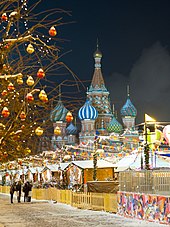January 2017 European cold wave
[1][6] On 9 January, the Continental Arctic (cA) air mass extended from Germany across the Balkans, resulting in deep snow in Greece and strong bora winds affecting Croatia in particular.
In addition, heavy snow in central and Southern Italy was the result of cold air flowing across the warmer Adriatic Sea.
Seven cold-related deaths were reported in Italy as of 9 January, mainly of homeless people,[10] and parts of the country experienced exceptional falls of snow, high winds and freezing temperatures.
[16] The islands of Euboea, Skopelos and Alonnisos declared a state of emergency after serious power failures and collapse of traffic due to snowfall.
[17] Mytilene on the island of Lesbos recorded a low of −5.7 °C (21.7 °F) on 7 January,[18] a temperature expected to occur on average once in 300 years in current climatic conditions.
[10] About 100,000 residents of settlements in Moscow Oblast such as Lyubertsy, Lytkarino, Dzerzhinsky and Kotelniki lost electricity due to extremely harsh temperatures.
Romanian Energy Minister, Toma Petcu, suggested that, if coal consumption remained high, reserves held by the country's two major producers would only last for four days.
Approximately one-third of the deaths were in Poland; others took place in Albania, Bulgaria, the Czech Republic, Italy, Greece, and North Macedonia.


